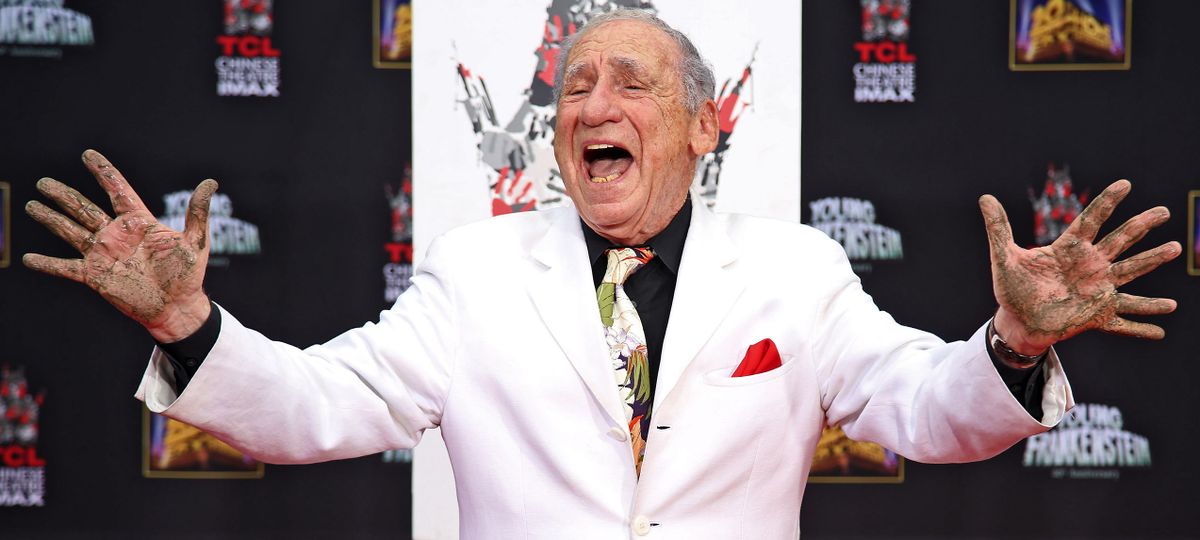He created a monster
Part spoof, part homage, Mel Brooks’ ‘Young Frankenstein’ turns 40
Mel Brooks displays his cement-covered hands, with his left hand sporting an extra finger, during his hand and footprint ceremony on the 40th anniversary of the movie “Young Frankenstein” in front of the TCL Chinese Theatre in the Hollywood section of Los Angeles on Monday. (Associated Press)
Director Mel Brooks spent a lot of money on white handkerchiefs while making his 1974 tour de farce, “Young Frankenstein.”
“I gave everybody in the crew a white handkerchief,” said the 88-year-old comedy legend during a recent phone interview. “I said, ‘When you feel like laughing, put this in your mouth.’ Every once in a while, I’d turn around and see a sea of white handkerchiefs, and I said, ‘I got a hit.’ ”
“Young Frankenstein” was more than a hit. It is a comic masterpiece.
Shot in glorious black-and-white, the comedy managed to be both a spoof and a loving homage to the Universal horror films – 1931’s “Frankenstein” and 1935’s “The Bride of Frankenstein,” both directed by James Whale, and 1939’s “Son of Frankenstein,” directed by Rowland V. Lee – that starred Boris Karloff as the monster.
Brooks co-wrote the Oscar-nominated script with the film’s star, Gene Wilder, who had starred in Brooks’ 1967 classic “The Producers” and 1974’s “Blazing Saddles.”
Wilder played the arrogant Dr. Frederick Frankenstein, who had so distanced himself from his family that he insisted his last name be pronounced “Frankensteen.” But when the good doctor visits the old family castle in Europe, it isn’t long before he creates his own monster (Peter Boyle).
Rounding out the cast of crazies were Madeline Kahn as Frederick’s tightly wound fiancee, Elizabeth; Marty Feldman as “Eye-Gore”; Cloris Leachman as the terrifying Frau Blücher; Teri Garr as the saucy Inga; Kenneth Mars as the one-armed Inspector Kemp; and Gene Hackman as the blind hermit.
Brooks, who has won Emmys, a Grammy, an Oscar and Tonys, put his hand and footprints in the famed TCL Chinese Theatre forecourt Monday morning as part of the film’s 40th-anniversary celebration.
And on Tuesday, Twentieth Century Fox Home Entertainment released a new Blu-ray version of the film.
It was Wilder who came up with the idea for “Young Frankenstein.” One day during production on “Blazing Saddles,” Brooks saw Wilder sitting in a corner with a legal pad “scribbling something in his cowboy outfit,” said Brooks.
“I said, ‘What are you doing?’ He said, ‘I have an idea for a movie. It’s about the grandson of Victor Frankenstein, and he wants nothing to do with the family, but sooner or later he will get sucked into the family insanity.’ ”
After filming ended that day on “Blazing Saddles,” the two worked until 2 a.m. on ideas for “Young Frankenstein.”
“We were very excited about were we could go, the possibilities, what was au courant we could make fun of,” he said. “We both knew we had to salute (novelist) Mary Shelley as well as James Whale. We had respect for the book and the movie.”
The film was originally set to be made at Columbia. But the studio executives nixed the idea of him shooting it in black-and-white like the original films. “I said then the deal is broken,” noted Brooks.
“Young Frankenstein” quickly found a new home at Fox after the film’s producer Michael Gruskoff gave the script to his friend Alan Ladd Jr., who had just taken over the reins of the studio. Dale Hennesy designed the sets that honored art director Charles D. Hall’s original designs for “Frankenstein” and “Bride of Frankenstein.” Gerald Hirschfeld supplied the atmospheric black-and-white cinematography.
For added authenticity, Brooks found Kenneth Strickfaden, who had created the seminal electrical equipment for the original horror films, so he could use it in “Young Frankenstein.”
“He had a garage in Santa Monica,” Brooks said. “I went to his garage, and there it was. He said, ‘OK, let me turn it on.’ He hit the switch, and it all went ‘buzzzzzz.’ ”
“I had a real problem,” said Brooks. “I didn’t want it to be just funny or silly. I wanted Mary Shelley’s basic feelings captured and the … haunting beautiful quality that James Whale got with Boris Karloff. My movies are not about jokes. They are about behavior, and behavior can be very funny.”
Brooks and Wilder had a disagreement over one of the movie’s many iconic moments – Frederick and the monster decked out in top hat and tails performing “Puttin’ on the Ritz.”
Wilder, Brooks related, “wanted to do ‘Puttin’ on the Ritz’ to show the prowess of the talent of the monster. I said, ‘No, no, no, we can’t do that. It will make it silly.’ ”
But Brooks gave in because Wilder “never stopped annoying me,” he said, laughing. “We shot it, put it in the picture, and we loved it.”
When he screened the rough cut of “Young Frankenstein” to a small audience on the Fox lot, he warned them that at nearly two hours long, the movie “would be a total failure,” but added that if they came back in a month, it would be “a brilliant, funny, remarkable success.”
During that month in the editing bay, “I did my homework,” said Brooks, who realized that there was too much comedy in the film. He cut the weaker comic moments and “spaced out when I wanted the audience to breathe out and relax. I got the rhythm of the movie right.”
“ ‘Young Frankenstein,’ ” he said, is “by far the best movie I ever made. Not the funniest – ‘Blazing Saddles’ was the funniest, and hot on its heels would be ‘The Producers.’ But as a writer-director, it is by far my finest.”

